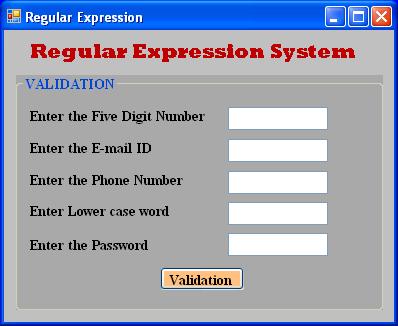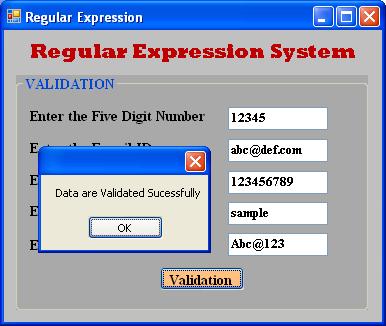Introduction
This article describes an approach to validating text box entries against a regular expression.
Regular expressions are the best and the easiest way to do data validation.You can use regular expressions to match and validate the text that users enter in the Textboxes. Ordinary characters are combined with special characters to define the match pattern. The validation succeeds only if the user input matches the pattern.
Regular expressions let you check input text for a wide variety of custom conditions for which the input must follow a specific pattern. You can concatenate simple regular expressions into complex search criteria to validate against complex patterns, such as any of several words with different endings.
Background
Special characters
Because special characters are the operators in regular expressions, in order to represent a special character as an ordinary one, you must escape it by preceding it with a backslash. For example, use two backslash characters (\\) to represent a backslash character.
Single-character regular expressions
The following rules govern regular expressions that match a single character:
- Special characters are: + * ? . [ ^ $ ( ) { | \
- Any character that is not a special character or escaped by being preceded by a backslash (\) matches itself.
- A backslash (\) followed by any special character matches the literal character itself; that is, the backslash escapes the special character.
- A period (.) matches any character except newline.
- A set of characters enclosed in brackets ([]) is a one-character regular expression that matches any of the characters in that set. For example, "[akm]" matches an a, k, or m. If you include ] (closing square bracket) in square brackets, it must be the first character. Otherwise, it does not work, even if you use \].
- A dash can indicate a range of characters. For example, [a-z] matches any lowercase letter.
- If the first character of a set of characters in brackets is the caret (^), the expression matches any character except those in the set. It does not match the empty string. For example: "[^akm]" matches any character except a, k, or m. The caret loses its special meaning if it is not the first character of the set.
- You can make regular expressions case insensitive by substituting individual characters with character sets; for example, "[Nn][Ii][Cc][Kk]" is a case-insensitive pattern for the name Nick (or NICK, or nick, or even nIcK).
- You can use the following escape sequences to match specific characters or character classes:
|
Escape
seq
|
Matches
|
Escape
seq
|
Meaning
|
|
[\b]
|
Backspace.
|
\s
|
Any of the following white space characters: space, tab, form feed, and line feed.
|
|
\b
|
A word boundary, such as a space.
|
\S
|
Any character except the white space characters matched by \s.
|
|
\B
|
A nonword boundary.
|
\t
|
Tab.
|
|
\cX
|
The control character Ctrl-x. For example, \cv matches Ctrl-v, the usual control character for pasting text.
|
\v
|
Vertical tab.
|
|
\d
|
A digit character [0-9].
|
\w
|
An alphanumeric character or underscore. The equivalent of [A-Za-z0-9_].
|
|
\D
|
Any character except a digit.
|
\W
|
Any character not matched by \w. The equivalent of [^A-Za-z0-9_].
|
|
\f
|
Form feed.
|
\n
|
Backreference to the nth expression in parentheses. See Backreferences.
|
|
\n
|
Line feed.
|
\ooctal
|
The character represented in the ASII character table by the specified octal number.
|
|
\r
|
Carriage return.
|
\xhex
|
The character represented in the ASCII character table by the specified hexadecimal number.
|
Multicharacter regular expressions
Use the following rules to build a multicharacter regular expression:
- Parentheses group parts of regular expressions together into a subexpression that can be treated as a single unit. For example, "(ha)+" matches one or more instances of ha.
- A one-character regular expression or grouped subexpression followed by an asterisk (*) matches zero or more occurrences of the regular expression. For example, "[a-z]*" matches zero or more lowercase characters.
- A one-character regular expression or grouped subexpression followed by a plus sign (+) matches one or more occurrences of the regular expression. For example, "[a-z]+" matches one or more lowercase characters.
- A one-character regular expression or grouped subexpression followed by a question mark (?) matches zero or one occurrences of the regular expression. For example, "xy?z" matches either xyz or xz.
- The carat (^) at the beginning of a regular expression matches the beginning of the field.
- The dollar sign ($) at the end of a regular expression matches the end of the field.
- The concatenation of regular expressions creates a regular expression that matches the corresponding concatenation of strings. For example, "[A-Z][a-z]*" matches any capitalized word.
- The OR character (|) allows a choice between two regular expressions. For example, "jell(y|ies)" matches either jelly or jellies.
- Braces ({}) indicate a range of occurrences of a regular expression. You use them in the form "{m, n}" where m is a positive integer equal to or greater than zero indicating the start of the range and n is equal to or greater than m, indicating the end of the range. For example, "(ba){0,3}" matches up to three pairs of the expression ba. The form "{m,}" requires at least m occurrences of the preceding regular expression. The form "{m}" requires exactly m occurrences of the preceding regular expression. The form "{,n}" is not allowed.
Backreferences
Backreferencing lets you match text in previously matched sets of parentheses. A slash followed by a digit n (\n) refers to the nth parenthesized subexpression.
One example of how you can use backreferencing is searching for doubled words; for example, to find instances of "the the" or "is is" in text. The following example shows backreferencing in a regular expression:
(\b[A-Za-z]+)[ ]+\1
This code matches text that contains a word that is repeated twice; that is, it matches a word, (specified by the \b word boundary special character and the "[A-Za-z]+)" followed by one or more spaces (specified by "[ ]+"), followed by the first matched subexpression, the first word, in parentheses. For example, it would match "is is", but not "This is".
Exact and partial matches
ColdFusion validation normally considers a value to be valid if any of it matches the regular expression pattern. Often you might want to ensure that the entire entry matches the pattern. If so, you must "anchor" it to the beginning and end of the field, as follows:
- If a caret (^) is at the beginning of a pattern, the field must begin with a string that matches the pattern.
- If a dollar sign ($) is at the end of a pattern, the field must end with a string that matches the pattern.
- If the expression starts with a caret and ends with a dollar sign, the field must exactly match the pattern.
Expression examples
The following examples show some regular expressions and describe what they match:
|
Expression
|
Description
|
|
[\?&]value=
|
Any string containing a URL parameter value.
|
|
^[A-Z]:(\\[A-Z0-9_]+)+$
|
An uppercase Windows directory path that is not the root of a drive and has only letters, numbers, and underscores in its text.
|
|
^(\+|-)?[1-9][0-9]*$
|
An integer that does not begin with a zero and has an optional sign.
|
|
^(\+|-)?[1-9][0-9]*(\.[0-9]*)?$
|
A real number.
|
|
^(\+|-)?[1-9]\.[0-9]*E(\+|-)?[0-9]+$
|
A real number in engineering notation.
|
|
a{2,4}
|
A string containing two to four occurrences of a: aa, aaa, aaaa; for example, aardvark, but not automatic.
|
|
(ba){2,}
|
A string containing least two ba pairs; for example, Ali baba, but not Ali Baba.
|
Sample Example for Validating the Data
This sample example is used to validate the textbox entries against the regular Expression.In the example provided, the validation function is used in conjunction with an error provider control. Whenever a Textbox control fails the validation test, the error provider is used to display an error indication adjacent to the control containing the error.This following example Contains Validation
- For FiveDigit Number,
- For Email ID,
- For Phone number,
- For Lowercase Letter and
- Finally,For the Password.

Figure 1.Textboxes are used for Validating Data
Whenever a Textbox control fails the validation test, the error provider is used to display an error indication adjacent to the control containing the error.

Figure 2.Textbox Control used with Error Provider
using the Error Provider,the information regarding the error are displayed as shown above.
The class begins with the following code:
using System;
using System.Collections.Generic;
using System.ComponentModel;
using System.Data;
using System.Text.RegularExpressions;
using System.Drawing;
using System.Text;
using System.Windows.Forms;
namespace regular_Expression
{
public partial class Expression : Form
{
public Expression()
{
InitializeComponent();
}
After the class is initiated, a region called "Controls" is defined and for each of the regular expression text boxes, the validating event is handled;
using the Regex.IsMatch method,the Data are Validated Against the Regular Expression specified using Regex as shown below;
#region Controls
private void btnValid_Click(object sender, EventArgs e)
{
errorProvider1.Clear();
errorProvider2.Clear();
errorProvider3.Clear();
errorProvider4.Clear();
errorProvider5.Clear();
Regex number = new Regex(@"^\d{5}$");
if (number.IsMatch(txtNumber.Text))
{
txtNumber.BackColor = Color.White;
txtNumber.ForeColor = Color.Black;
}
else
{
errorProvider1.SetError(txtNumber, "Eg 12345");
txtNumber.ForeColor = Color.Black;
}
Regex id = new Regex(@"\w+([-+.']\w+)*@\w+([-.]\w+)*\.\w+([-.]\w+)*");
if (id.IsMatch(txtMail.Text))
{
txtMail.BackColor = Color.White;
txtMail.ForeColor = Color.Black;
}
else
{
errorProvider2.SetError(txtMail,"eg abd@yahoo.com");
txtMail.ForeColor = Color.Black;
}
Regex phonenum = new Regex(@"(\(\d{3}\)|\d{3}-)?\d{8}");
if (phonenum.IsMatch(txtPhoneNo.Text))
{
txtPhoneNo.BackColor = Color.White;
txtPhoneNo.ForeColor = Color.Black;
}
else
{
errorProvider3.SetError(txtPhoneNo,"Eg 9994998765");
txtPhoneNo.ForeColor = Color.Black;
}
Regex lowercase = new Regex(@"(\b[^\WA-Z0-9]+\b)");
if (lowercase.IsMatch(txtlowercase.Text))
{
txtlowercase.ForeColor = Color.Black;
txtlowercase.BackColor = Color.White;
}
else
{
errorProvider4.SetError(txtlowercase, "Eg country");
txtlowercase.ForeColor = Color.Black;
}
Regex pwd = new Regex(@"^(?=.*\d)(?=.*[a-z])(?=.*[A-Z])
(?=.*[!@#%&*|\:;<>,.?/]).{4,8}$");
if (pwd.IsMatch(txtPassword.Text))
{
txtPassword.BackColor = Color.White;
txtPassword.ForeColor = Color.Black;
}
else
{
errorProvider5.SetError(txtPassword, "Eg Ksr@48");
txtPassword.ForeColor = Color.Black;
}
if (number.IsMatch(txtNumber.Text) &&
id.IsMatch(txtMail.Text) &&
phonenum.IsMatch(txtPhoneNo.Text) &&
lowercase.IsMatch(txtlowercase.Text) &&
pwd.IsMatch(txtPassword.Text))
{
MessageBox.Show("Data are Validated Sucessfully");
}
}
#endregion
}
}

Figure 3. Validation of the Data Against Regular Expressions
After Clicking the Validation Button,if all the Textboxes are validated(matched ) against the Regex Expression value then it display the Message with "Data are Validated Sucessfully".If any Textbox failed to validation test, the error provider is used to display an error indication adjacent to the control containing the error..
Download this Sample Application By clicking this:Download regular_Expression.zip - 41.78 KB
Summary
This article demonstrates an approach to validating user input against a regular expression in a win forms application. The approach is based upon extending the standard win forms text box control to allow storage of a regular expression and to provide the means to validate the text contained in the control against the pattern defined in the regular expression.
